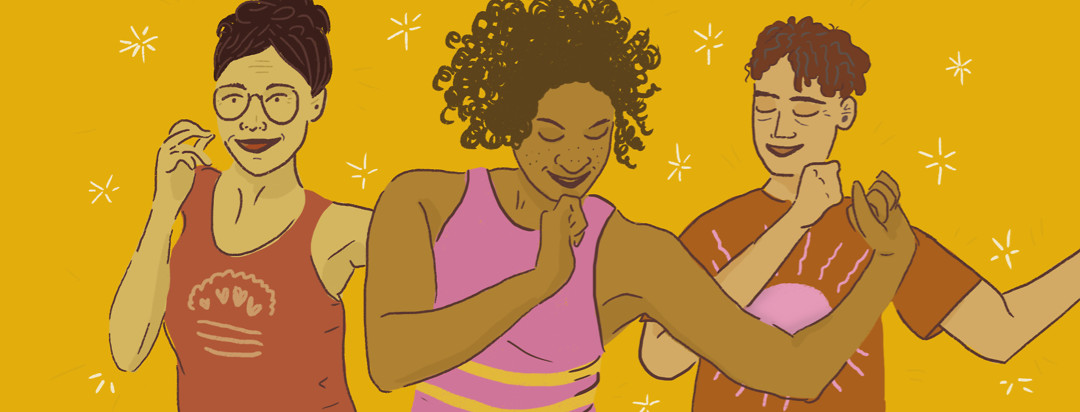Beth Hochstein: From Dancer to Dance Instructor to Dancing Fundraiser for PD
 I recently started researching how dance can be a great exercise option for people with Parkinson's disease (PD). Over and over, Beth Hochstein's name kept coming up in the Google searches, as a Zumba instructor with PD. After reading a few articles about Beth, I wanted to interview this fellow Zumba instructor to learn more about her story. She graciously agreed to the interview.
I recently started researching how dance can be a great exercise option for people with Parkinson's disease (PD). Over and over, Beth Hochstein's name kept coming up in the Google searches, as a Zumba instructor with PD. After reading a few articles about Beth, I wanted to interview this fellow Zumba instructor to learn more about her story. She graciously agreed to the interview.
A surprising diagnosis at age 36 with young-onset PD
Twelve years ago, Beth had a thriving podiatry practice with her husband and was a mom to two young children when she started noticing some stiffness and freezing in some of her muscles. Next, came a hand tremor. In denial, she ignored these symptoms until they became apparent to others. She was devastated upon receiving a diagnosis of young-onset PD.
However, she continued in her career for a few more years. On medication, her symptoms were not very visible to others. Meanwhile, her doctor had encouraged her to exercise. Up through her first pregnancy, Beth had been a lifelong dance enthusiast, taking ballet, tap and jazz classes. So, she decided to return to dance. Soon after her diagnosis, she discovered Zumba® Fitness.
Zumba was her answer
Zumba is a fitness-based dance format that uses Latin and World music, along with some pop, to get people moving to the beat. Beth fell passionately in love with Zumba from the outset, and she found that it actually helped with some of her Parkinson's symptoms. She shares, "Zumba was perfect for me because I became so distracted with the fun I was having, that I forgot I was exercising!"
Eventually, Beth decided to retire from her podiatry practice. She also decided to go "all in" with Zumba and become a licensed Zumba instructor. Beth taught for a few years, focusing on other students with PD, at various levels of functioning. She also attended Dance with PD® training and began co-teaching classes with a friend, using some of her Zumba music.
Beth told me that it's been her experience that even when you're feeling stiff and shaky, once the music starts in a Zumba class, everything changes. Suddenly the movement flows more fluidly and you find yourself able to do things you couldn't do without the music. Other benefits Beth and her students have experienced with dancing included:
- Lifts mood
- The adrenalin that you generate helps the PD meds last longer
- Provides a respite from chronic illness and coordination issues
- Helps with muscle memory
Beth is no longer teaching Zumba or Dance with PD, because she found it too stressful, given her condition. But she continues to attend Zumba and HIIT classes as a student.
Next step: Fundraiser extraordinaire
When she was still teaching Zumba, Beth received a lot of support from the Zumba Fitness organization. They honored her at one of their annual conventions for her work with PD patients in her Zumba classes. They also helped her with a Zumbathon® in 2013 that attracted 800 participants and raised more than $40,000 for PD research. And a few years back, Zumba even made her a backup dancer avatar in one of their video games.
Beth also started working with the Michael J. Fox Foundation for Parkinson's Research, becoming a Team Fox Member and Mentor. She started organizing an annual dance party to raise money for PD research and awareness. Over time, this led her to start her own charitable foundation four years ago, which is specifically organized around dance. She calls it Dance Party for Parkinsons, Inc.
Beth's foundation funds all types of events, including Zumba, PIYO and cycling classes, and even cocktail parties. All of these events are used to raise money for Dance with PD classes and research. Their latest project is a series of fitness classes featuring renowned fitness experts like:
- Lucrecia Venosta, an international Zumba Education Specialist®
- David Leventhal, program director, professional dancer and founding teacher for the Dance with PD® program
- Sharon Epstein, acclaimed yoga teacher, dance therapist and health coach
- Nathan Blake, creator of Urban Groove Therapy
Beth continues to push through
Although Beth has encountered a number of challenges over the years with her Parkinson's disease, she continues to push through. She experienced dyskinesia, a side effect from taking Sinemet, a common PD medication, a while back. But thanks to one of the newer PD meds, she is no longer having problems with that symptom.
Beth continues to stay as active as she can. She really believes in the power of exercise and activity for people with Parkinson's. Her disease has progressed, but it is still not terrible thanks to medication, her active lifestyle, and her positive attitude toward life. Mornings are the hardest, when dystonia in her lower back and neck cause a lot of pain, at least until her morning medication kicks in.
In summary
Beth emphasizes the value of any kind of exercise when you have PD. But dance can be especially beneficial, although she says it can sometimes be a hard sell for men. She's also found that people with young-onset PD may be reluctant to get started because they often hide their illness until they figure out next steps. She did that herself.
But the sooner you can get started with dance, the better! She says it can make a difference with the progression of the illness and with your self-image. So, why not be like Beth, and give a dance class a try? You just might fall in love with it as Beth did!
Community Poll
Do you get mood swings?

Join the conversation